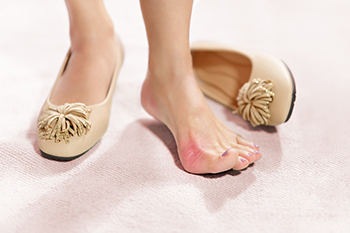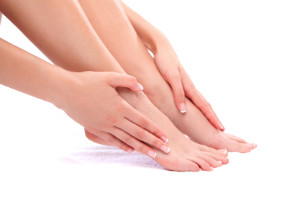Baytown, TX (281) 837-8371
April 2023
3 Grades of Ankle Sprains

An unexpected fall may result in an ankle sprain. It can happen from suddenly stepping off of a curb and occurs when the ligaments stretch beyond their normal range of motion. Swelling, pain, and an inability to walk are often associated with an ankle sprain and generally require prompt medical attention. A lateral ankle sprain happens when the foot rolls inward while damaging the outer ankle. It is less common to injure the inner ankle, and a syndesmotic sprain may happen during a contact sport. Sprains are categorized into three grades, based on severity. When the ligaments are mildly stretched and accompanied by minimal pain and swelling, this may be a Grade 1 sprain. A partially torn ligament may produce moderate pain, and will fall into the Grade 2 sprain. Finally, a Grade 3 sprain consists of intense pain, and the patient is unable to walk. If you have sprained your ankle, it is suggested that you seek the counsel of a podiatrist who can help you with proper treatment methods.
Ankle sprains are common but need immediate attention. If you need your feet checked, contact Abeer M. Foteh, DPM from Greater Houston Foot Centers. Our doctor can provide the care you need to keep you pain-free and on your feet.
How Does an Ankle Sprain Occur?
Ankle sprains take place when the ligaments in your ankle are torn or stretched beyond their limits. There are multiple ways that the ankle can become injured, including twisting or rolling over onto your ankle, putting undue stress on it, or causing trauma to the ankle itself.
What Are the Symptoms?
- Mild to moderate bruising
- Limited mobility
- Swelling
- Discoloration of the skin (depending on severity)
Preventing a Sprain
- Wearing appropriate shoes for the occasion
- Stretching before exercises and sports
- Knowing your limits
Treatment of a Sprain
Treatment of a sprain depends on the severity. Many times, people are told to rest and remain off their feet completely, while others are given an air cast. If the sprain is very severe, surgery may be required.
If you have suffered an ankle sprain previously, you may want to consider additional support such as a brace and regular exercises to strengthen the ankle.
If you have any questions please feel free to contact our office located in Baytown, TX . We offer the newest diagnostic and treatment technologies for all your foot and ankle needs.
Causes of Bunions

A hard lump on the side of the toe may be a bunion. It is considered to be a deformity, and large bunions may cause difficulty while wearing shoes. Women can be prone to developing bunions as a result of the high heels that are worn. They generally provide little room for the toes to move freely in, and this may cause the side of the big toe to rub on the shoe. Some patients notice their toes shifting toward each other, as the bunion may cause this misalignment. Corns and calluses may develop on top of the bunion, and putting a protective pad over it may bring relief. Pain may be caused by a bunion, and the toe may become numb or have a burning sensation. If you have developed a bunion, it is suggested that you speak to a podiatrist, who can offer you relief solutions, which may include minor surgery for removal.
If you are suffering from bunion pain, contact Abeer M. Foteh, DPM of Greater Houston Foot Centers. Our doctor can provide the care you need to keep you pain-free and on your feet.
What Is a Bunion?
Bunions are painful bony bumps that usually develop on the inside of the foot at the joint of the big toe. As the deformity increases over time, it may become painful to walk and wear shoes. Women are more likely to exacerbate existing bunions since they often wear tight, narrow shoes that shift their toes together. Bunion pain can be relieved by wearing wider shoes with enough room for the toes.
Causes
- Genetics – some people inherit feet that are more prone to bunion development
- Inflammatory Conditions - rheumatoid arthritis and polio may cause bunion development
Symptoms
- Redness and inflammation
- Pain and tenderness
- Callus or corns on the bump
- Restricted motion in the big toe
In order to diagnose your bunion, your podiatrist may ask about your medical history, symptoms, and general health. Your doctor might also order an x-ray to take a closer look at your feet. Nonsurgical treatment options include orthotics, padding, icing, changes in footwear, and medication. If nonsurgical treatments don’t alleviate your bunion pain, surgery may be necessary.
If you have any questions, please feel free to contact our office located in Baytown, TX . We offer the newest diagnostic and treatment technologies for all your foot care needs.
Causes of Peripheral Neuropathy

It is easy to recognize the symptoms of peripheral neuropathy, a condition that results from damage to the nerves in the body’s extremities. Burning, stabbing, and sometimes tingling pain in the feet are common, along with numbness and weakness. This is the result of the brain sending incorrect messages to the feet and toes. Peripheral neuropathy can be caused by diabetes, as the result of prolonged high blood sugar levels. Other causes include side effects of certain medications, hereditary factors, and autoimmune or kidney disease. It can also be a side effect of an underlying condition, such as obesity, alcohol abuse, and high blood pressure. In addition, a deficiency of vitamin B12 has been linked to developing peripheral neuropathy. While this condition is rarely cured, it can be managed to help reduce the symptoms. For more information about peripheral neuropathy that affects the feet and toes, it is suggested that you consult a podiatrist.
Neuropathy
Neuropathy can be a potentially serious condition, especially if it is left undiagnosed. If you have any concerns that you may be experiencing nerve loss in your feet, consult with Abeer M. Foteh, DPM from Greater Houston Foot Centers. Our doctor will assess your condition and provide you with quality foot and ankle treatment for neuropathy.
What Is Neuropathy?
Neuropathy is a condition that leads to damage to the nerves in the body. Peripheral neuropathy, or neuropathy that affects your peripheral nervous system, usually occurs in the feet. Neuropathy can be triggered by a number of different causes. Such causes include diabetes, infections, cancers, disorders, and toxic substances.
Symptoms of Neuropathy Include:
- Numbness
- Sensation loss
- Prickling and tingling sensations
- Throbbing, freezing, burning pains
- Muscle weakness
Those with diabetes are at serious risk due to being unable to feel an ulcer on their feet. Diabetics usually also suffer from poor blood circulation. This can lead to the wound not healing, infections occurring, and the limb may have to be amputated.
Treatment
To treat neuropathy in the foot, podiatrists will first diagnose the cause of the neuropathy. Figuring out the underlying cause of the neuropathy will allow the podiatrist to prescribe the best treatment, whether it be caused by diabetes, toxic substance exposure, infection, etc. If the nerve has not died, then it’s possible that sensation may be able to return to the foot.
Pain medication may be issued for pain. Electrical nerve stimulation can be used to stimulate nerves. If the neuropathy is caused from pressure on the nerves, then surgery may be necessary.
If you have any questions, please feel free to contact our office located in Baytown, TX . We offer the newest diagnostic and treatment technologies for all your foot care needs.
Are Bunions Affecting Your Everyday Life?
Several Reasons to Have Foot Pain

The feet carry the weight of the body and are responsible for walking, running, and jumping. They can become damaged, and various types of foot pain may be experienced. There are several different causes of foot pain and discomfort, and one reason may be from wearing shoes that do not fit correctly. Athlete’s foot is a common condition that many people get. It is defined as a fungal infection of the skin, and the feet may begin to itch, especially between the toes. Bunions are considered to be a deformity and are noticeable by the hard lump that develops on the side of the big toe. It can be caused by wearing shoes that do not have enough room for the toes to move freely in. People who have diabetes may have different levels of foot pain which can be accompanied by a numbing and tingling sensation. If you have foot pain for any reason, it is strongly suggested that you consult with a podiatrist who can determine what the cause is and offer relief and treatment options.
Foot Pain
Foot pain can be extremely painful and debilitating. If you have a foot pain, consult with Abeer M. Foteh, DPM from Greater Houston Foot Centers. Our doctor will assess your condition and provide you with quality foot and ankle treatment.
Causes
Foot pain is a very broad condition that could be caused by one or more ailments. The most common include:
- Bunions
- Hammertoes
- Plantar Fasciitis
- Bone Spurs
- Corns
- Tarsal Tunnel Syndrome
- Ingrown Toenails
- Arthritis (such as Gout, Rheumatoid, and Osteoarthritis)
- Flat Feet
- Injury (from stress fractures, broken toe, foot, ankle, Achilles tendon ruptures, and sprains)
- And more
Diagnosis
To figure out the cause of foot pain, podiatrists utilize several different methods. This can range from simple visual inspections and sensation tests to X-rays and MRI scans. Prior medical history, family medical history, and any recent physical traumatic events will all be taken into consideration for a proper diagnosis.
Treatment
Treatment depends upon the cause of the foot pain. Whether it is resting, staying off the foot, or having surgery; podiatrists have a number of treatment options available for foot pain.
If you have any questions, please feel free to contact our office located in Baytown, TX . We offer the newest diagnostic and treatment technologies for all your foot care needs.








